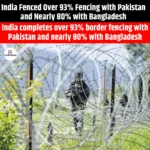US Embassy Clarifies No USAID Funding for Indian Elections
|
General Studies Paper II: Bilateral Groupings & Agreements, Effect of Policies & Politics of Countries on India’s Interests |
Why in News?
Recently the US Embassy denied claims made about USAID support for Indian elections by the US President. This official confirmation comes after earlier reports suggested otherwise.
US Embassy Clarifies No USAID Funding for Indian Elections
The US Embassy in New Delhi confirmed that USAID never funded voter turnout activities in India. This clarification came after months of speculation and claims that created confusion both in India and abroad.
- Background: In February 2025, the US Department of Government Efficiency (DOGE) reports emerged that USAID had allocated $21 million (around ₹182 crore) to encourage voter turnout in India. The claim gained traction when former US President Donald Trump referred to it multiple times, presenting it as an example of what he called “misuse of American aid money.” Following this, questions were raised in India’s Parliament about the authenticity of such funding.
- MEA’s Reply: On August 21, 2025, the MEA presented a written statement in the Rajya Sabha. The Minister of State confirmed that the US Embassy had denied any allocation of funds for electoral activities. The embassy clarified that between 2014 and 2024 USAID/India had neither received nor provided any such funding for voter turnout initiatives. The Indian government reported that the US Embassy announced the closure of all seven partnership agreements with India.
USAID Projects in India (2021–2024)
- Between 2021 and 2024, the United States Agency for International Development (USAID) supported several programs in India. The total assistance was ₹397 crore, given under seven partnership agreements already in place with the Government of India. The projects were diverse and focused on education, environment, health, and Tibetan community welfare.
- The largest share of the funds, ₹255 crore, went to organizations such as the Tibet Fund, Central Tibetan Relief Committee, Tibetan Children’s Education and Welfare Fund, and Tibetan Health Associations. The purpose was to strengthen the social, economic, and cultural life of Tibetans in India and Nepal.
- USAID also invested in projects aimed at improving learning outcomes for children from poor backgrounds.
- CARE India Solutions received ₹26 crore to work in states like Jharkhand, Uttar Pradesh, Bihar, and Delhi. The focus was to help disadvantaged children build essential learning skills.
- Palladium International was granted ₹26 crore to run programs that improve the lives of poor children and families.
- Pratham Education Foundation, a leading Indian NGO, received ₹28 crore to strengthen the public education system. Its work targeted better teaching practices and access to quality education.
- Room to Read was granted a total ₹18.27 crore to launch creative reading programs and activities in public schools. The initiative promoted literacy at an early stage and encouraged children to continue their education.
- USAID also addressed environmental concerns through partnerships with Indian institutions. The Council on Energy, Environment and Water (CEEW) received ₹16.97 crore. The project aimed to design an advanced model for air pollution reduction and promote sustainable practices to improve urban air quality.
What is the United States Agency for International Development (USAID)?
- About: The United States Agency for International Development (USAID) is the main foreign aid agency of the United States. It manages most of the country’s development and humanitarian programs abroad. It was created to help partner countries improve lives and reduce poverty.
- Origin: USAID was established on November 3, 1961 by an executive order of President John F. Kennedy. The agency came into existence under the Foreign Assistance Act of 1961. Before USAID, American aid was managed through different programs and scattered departments.
- Objectives: USAID has clear objectives that guide its global work:
-
-
- Promote economic growth in developing countries.
- Support health programs, including maternal care, child vaccination, HIV/AIDS, and malaria prevention.
- Strengthen education systems to give children access to schools and literacy.
- Provide emergency relief during natural disasters and conflicts.
- Encourage democracy and governance reforms in partner countries.
- Support climate change adaptation and renewable energy projects.
-
- Structure: USAID functions as an independent agency but works under the guidance of the US State Department. USAID is led by an Administrator chosen by the President and approved by the Senate. USAID operates through missions in partner countries. Washington, D.C., USA is the headquarters of USAID. As of now, USAID has active missions in more than 100 countries.
- Features: Some key features of USAID include:
-
-
- USAID provides both development assistance and humanitarian relief in crises.
- The agency prioritizes long-term development in health, education, agriculture, and environmental sectors.
- USAID partners with governments, NGOs, private sector, and local communities in host countries.
- The agency operates through country missions that design and manage local projects.
- USAID’s budget is approved by the US Congress, ensuring oversight and accountability.
- The agency adapts its programs to local needs while aligning with US foreign policy goals.
- This agency is one of the largest aid agencies in the world.
-
- Process: The US government first identifies regions where aid matches foreign policy interests and humanitarian needs. The partner country often signs bilateral agreements with the United States to implement projects. Local governments, NGOs, and international organizations work with USAID to carry out these programs. For this funds are allocated for specific sectors. After funding, regular monitoring is done by the agency to ensure transparency and accountability.
- Modes of Assistance:
-
- USAID often provides technical assistance by sharing expertise and knowledge. Experts train local officials, teachers, or health workers to improve their skills. For example, in Kenya in 2022, USAID supported health professionals with training programs on HIV/AIDS prevention.
- Another mode is financial assistance, where USAID funds projects and programs directly. The funds are used to buy equipment, run schools, or support food aid. In Haiti after the 2010 earthquake, USAID provided significant financial support for rebuilding homes and hospitals.
- USAID also promotes public–private partnerships by working with businesses and organizations. These partnerships bring innovation and investment along with development goals. In Nigeria in 2021, USAID partnered with private companies to expand access to renewable energy in rural areas.









